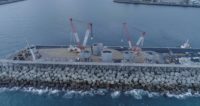
T he United State's first public-operated, multiple-turbine wind-research test facility recently completed its first phase of construction. It is designed to test the physics of how wind turbines interact in a wind array.
The $4.5-million facility, dubbed SWiFT for "scaled wind-farm technology," is the result of a partnership between the U.S. Dept. of Energy, Sandia National Laboratories, Vestas Wind Systems, Texas Tech University and Group NIRE, a clean-energy financial consultant and project developer.
"There are a lot of black boxes—proprietary technologies in this industry," says John Schroeder, director of the Wind Science and Engineering Research Center at Texas Tech University.
Schroeder says the research partnership will make its findings public to help advance wind technology. "The architecture is wide open," he says. Now that the first three turbines are erected, researchers will spend 12 months debugging, says Schroeder, assessing the array's power output and loads.
After establishing benchmarks, researchers will start making changes to the array. They will switch out the controllers and manipulate the angles of the blades, says Schroeder.
The partnership plans to add as many as seven more turbines to the array. Keeping construction costs low is a primary objective. "The turbines at this site are smaller than utility-scale turbines," says Joshua Paquette, mechanical engineer with Sandia National Laboratories, Albuquerque. "This allowed for 90% savings." All the research can be scaled up to benefit larger-size turbines.
"This is as small as you can effectively go and still get results that will transfer," says Schroeder. "Plus, we didn't have to wait around for a bigger crane." The facility will sell any power it produces to local utilities, using the profits to support Texas Tech Ph.D. student research.



Post a comment to this article
Report Abusive Comment